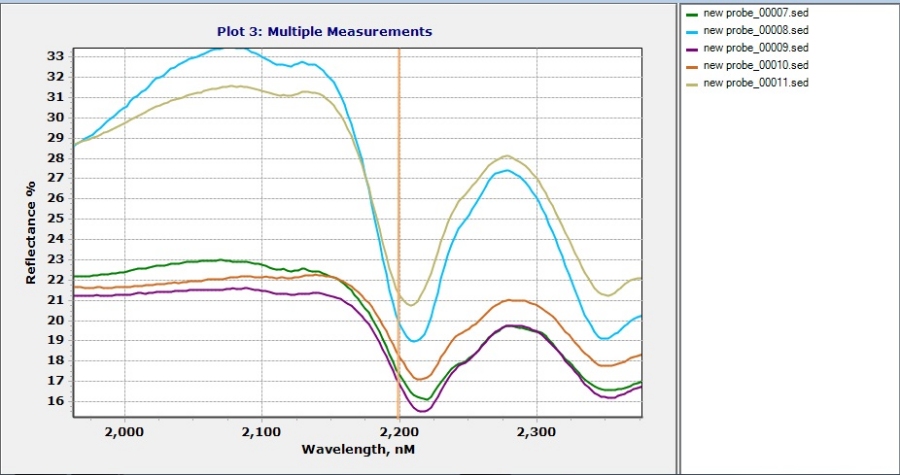
White mica shift
Lawrence, MA – March 23, 2017 – During exploration for unconformity-type uranium deposits like those in the Athabascan basin, the clay illite can be a reasonable pathfinder mineral. In sandstone and basement-hosted deposits, alteration halos that include clay mineral alteration features can contain illite, sudoitic chlorite, dravite, dickite, and kaolinite.
Illite types can be diagenetic (coarse grained and platy) or hydrothermal (hairy/wispy). There is a small increase in aluminum (Al) content in hydrothermal illite relative to diagenetic illite. The shift to greater Al content can be more easily seen near 2200 nanometers using Spectral Evolution’s new ultra,high resolution SR-6500 portable spectroradometer.
Resolution at FWHM for the SR6500 is:
Resolution is achieved using three high density solid state thermoelectrically cooled photodiode arrays:
Using EZ-ID software with the SR-6500 enables fast and accurate mineral identification of illite from other clays. EZ-ID matches the target spectra against two libraries of more than 600 minerals and 1600 spectra. It also allows you to create your own project-specific library from known samples as you scan.
Illite typically has two absorption peaks at 1400 and 2200nm.. The 1400 feature is derived from the OH-overtone stretching vibration while the 2200 feature is related to the Al-OH bending combined with OH stretching. To see the shift in illite associated with uranium deposits, the hydrothermal illite will have a small but higher concentration of Al as opposed to the diagenetic illite and will show absorption features at 2190 nm and 2200 nm as opposed to the diagenetic illite which will show the absorption feature at 2205, 2210, 2220 nm. By tracking the alteration changes in illite a geologist can get a better idea of how close an ore body might be and create a more accurate mineral map prior to drilling or by scanning core after a few test holes have been drilled.
For more information, visit:
http://www.spectralevolution.com/applications_uranium_illite.html
About SPECTRAL EVOLUTION
Established in 2004, SPECTRAL EVOLUTION is a leading manufacturer of laboratory and handheld portable spectrometers, spectroradiometers and spectrophotometers. SPECTRAL EVOLUTION spectrometers are used worldwide for many mission-critical lab and field applications in mining, remote sensing, vegetative studies, ground truthing, environmental and climate studies, developing satellite calibrations, and more, due to their reliable, robust, rugged design and user-friendly one-touch features.
SPECTRAL EVOLUTION maintains a facility in Lawrence, Massachusetts which houses design, prototyping, manufacturing and service facilities for the instruments that it markets and sells worldwide, either through direct sales, OEM sales or through distributor agents.